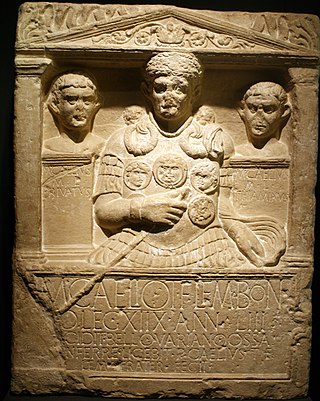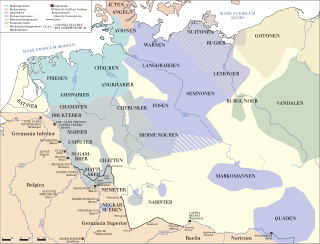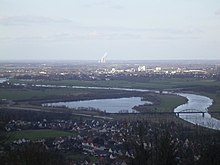
The Suebi were a large group of Germanic peoples originally from the Elbe river region in what is now Germany and the Czech Republic. In the early Roman era they included many peoples with their own names such as the Marcomanni, Quadi, Hermunduri, Semnones, and Lombards. New groupings formed later, such as the Alamanni and Bavarians, and two kingdoms in the Migration Period were simply referred to as Suebian.

The Battle of the Teutoburg Forest, described as the Varian Disaster by Roman historians, took place at modern Kalkriese in AD 9, when an alliance of Germanic peoples ambushed Roman legions and their auxiliaries, led by Publius Quinctilius Varus. The alliance was led by Arminius, a Germanic officer of Varus's auxilia. Arminius had acquired Roman citizenship and had received a Roman military education, which enabled him to deceive the Roman commander methodically and anticipate the Roman army's tactical responses.

The Chatti were an ancient Germanic tribe whose homeland was near the upper Weser (Visurgis), whose name might mean "pursuers". They lived in central and northern Hesse and southern Lower Saxony, along the upper reaches of that river and in the valleys and mountains of the Eder and Fulda regions, a district approximately corresponding to Hesse-Kassel, though probably somewhat more extensive. They settled within the region in the first century BC. According to Tacitus, the Batavians and Cananefates of his time, tribes living within the Roman Empire, were descended from part of the Chatti, who left their homeland after an internal quarrel drove them out, to take up new lands at the mouth of the Rhine.

Arminius was a chieftain of the Germanic Cherusci tribe who is best known for commanding an alliance of Germanic tribes at the Battle of the Teutoburg Forest in 9 AD, in which three Roman legions under the command of general Publius Quinctilius Varus were destroyed. His victory at Teutoburg Forest would precipitate the Roman Empire's permanent strategic withdrawal from Germania Magna. Modern historians have regarded Arminius' victory as one of Rome's greatest defeats. As it prevented the Romanization of Germanic peoples east of the Rhine, it has also been considered one of the most decisive battles in history and a turning point in human history.

The Chauci were an ancient Germanic tribe living in the low-lying region between the Rivers Ems and Elbe, on both sides of the Weser and ranging as far inland as the upper Weser. Along the coast they lived on artificial mounds called terpen, built high enough to remain dry during the highest tide. A dense population of Chauci lived further inland, and they are presumed to have lived in a manner similar to the lives of the other Germanic peoples of the region.

The Cherusci were a Germanic tribe that inhabited parts of the plains and forests of northwestern Germany in the area of the Weser River and present-day Hanover during the first centuries BC and AD. Roman sources reported they considered themselves kin with other Irmino tribes and claimed common descent from an ancestor called Mannus. During the early Roman Empire under Augustus, the Cherusci first served as allies of Rome and sent sons of their chieftains to receive Roman education and serve in the Roman army as auxiliaries. The Cherusci leader Arminius led a confederation of tribes in the ambush that destroyed three Roman legions in the Teutoburg Forest in AD 9. He was subsequently kept from further damaging Rome by disputes with the Marcomanni and reprisal attacks led by Germanicus. After rebel Cherusci killed Arminius in AD 21, infighting among the royal family led to the highly Romanized line of his brother Flavus coming to power. Following their defeat by the Chatti around AD 88, the Cherusci do not appear in further accounts of the German tribes, apparently being absorbed into the late classical groups such as the Saxons, Thuringians, Franks, Bavarians, and Allemanni.

The Ampsivarii, sometimes referenced by modern writers as Ampsivari, were a Germanic tribe mentioned by ancient authors.

The Bructeri were a Germanic tribe in Roman imperial times, located in northwestern Germany, in present-day North Rhine-Westphalia. Their territory included both sides of the upper Ems and Lippe rivers. At its greatest extent, their territory apparently stretched between the vicinities of the Rhine in the west and the Teutoburg Forest and Weser river in the east. In late Roman times they moved south to settle upon the east bank of the Rhine facing Cologne, an area later associated with the Ripuarian Franks.

The Battle of the Weser River, sometimes known as the First Battle of Minden or Battle of Idistaviso, was fought in 16 AD between Roman legions commanded by Roman Emperor Tiberius's heir and adopted son, Germanicus, and an alliance of Germanic peoples, commanded by Arminius. The battle marked the end of a three-year series of campaigns by Germanicus in Germania.

This is a chronology of warfare between the Romans and various Germanic peoples between 113 BC and 476. The nature of these wars varied through time between Roman conquest, Germanic uprisings and later Germanic invasions of the Western Roman Empire that started in the late second century BC. The series of conflicts was one factor which led to the ultimate downfall of the Western Roman Empire in particular and ancient Rome in general in 476.

The Chamavi, Chamãves or Chamaboe (Χᾳμαβοί) were a Germanic tribe of Roman imperial times whose name survived into the Early Middle Ages. They first appear under that name in the 1st century AD Germania of Tacitus as a Germanic tribe that lived to the north of the Lower Rhine. Their name probably survives in the region today called Hamaland, which is in the Gelderland province of the Netherlands, between the IJssel and Ems rivers.

The Chasuarii were an ancient Germanic tribe known from the reports of authors writing in the time of the Roman Empire. They lived somewhere to the east and north of the Rhine, near the modern river Hase, which feeds into the Ems. This means they lived near modern Osnabrück.
Segestes was a nobleman of the Germanic tribe of the Cherusci involved in the events surrounding the Roman attempts to conquer northern Germany during the reign of Roman Emperor Augustus.

Thusnelda was a Germanic Cheruscan noblewoman who was captured by the Roman general Germanicus during his invasion of Germania. She was the wife of Arminius. Tacitus and Strabo cite her capture as evidence of both the firmness and restraint of Roman arms.

The Chattuarii, also spelled Attoarii, were a Germanic tribe of the Franks. They lived originally north of the Rhine in the area of the modern border between Germany and the Netherlands, but then moved southwards in the 4th century, as a Frankish tribe living on both sides of the Rhine.

The Dulgubnii are a Germanic tribe mentioned in Tacitus' Germania as living in what is today northwest Germany. Tacitus describes them being to the north of the Angrivarii and Chamavi, and as having moved from the north into the area once belonging to the Bructeri, between Ems, Lippe, and Weser. In this same area as the Dulgubnii, north of the Chamavi and Angrivarii, were the Chasuarii, and north of these, on the North Sea coast, where the Chauci. The Chasuarii's name is thought to derive from the River Hase which feeds into the middle of the Ems from the east, just northwest of the area associated with the Angrivarii, on the Weser. So from Tacitus, it appears that the Dulgubnii probably lived near the Weser.
The Tubantes were a Germanic tribe, living in the eastern part of the Netherlands, north of the Rhine river. They are often equated to the Tuihanti, who are known from two inscriptions found near Hadrian's Wall. The modern name Twente derives from the word Tuihanti.

Germania was a short-lived Roman province for the duration of 16 years under Augustus, from 7 BC to AD 9. The possible capital of this province was Marktbreit, a castrum with a nearby canaba from the period of Emperor Augustus, located 70 km east of the "Limes Germanicus" on the River Main.

The Roman campaigns in Germania were a series of conflicts between the Germanic tribes and the Roman Empire. Tensions between the Germanic tribes and the Romans began as early as 17/16 BC with the Clades Lolliana, where the 5th Legion under Marcus Lollius was defeated by the tribes Sicambri, Usipetes, and Tencteri. Roman Emperor Augustus responded by rapidly developing military infrastructure across Gaul. His general, Nero Claudius Drusus, began building forts along the Rhine in 13 BC and launched a retaliatory campaign across the Rhine in 12 BC.
The Battle of the Angrivarian Wall was fought near Porta Westfalica, Germany in 16 AD between the Roman general Germanicus and an alliance of Germanic tribes commanded by Arminius. This battle followed immediately after the Battle of Idistaviso, and was supposedly sparked by Germanic outrage over the trophy erected on that prior battlefield by the Romans.













